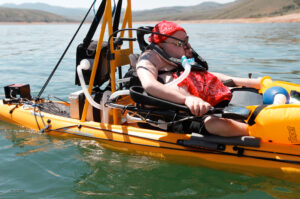
University of Utah researchers and physicians have collaborated to create new outdoor recreation equipment, including kayaks and bicycles, designed to get spinal cord injury patients back into the great outdoors. The equipment is the product of a unique collaboration between University rehabilitation physicians and the U’s Department of Mechanical Engineering. “These pieces are fresh out of the engineering lab,” says Dr. Jeffrey Rosenbluth, medical director of University of Utah Health Care’s Spinal Cord Injury Acute Rehabilitation Program. “We’re really concentrating on the hardest people to get into active living and sports. When coming up with these design plans, we asked, ‘How can we give these individuals the ultimate experience?’ ”
Rosenbluth coordinated with mechanical engineering professor Andrew Merryweather to make his vision a reality, and the Craig H. Neilsen Foundation financially backed the projects. (The late Neilsen MBA’64 JD’67, a casino executive who became a quadriplegic after a 1985 automobile accident, established the foundation in 2002 to fund spinal cord injury research and rehabilitation.) Describing some of the innovative features of the team’s new hand-cycle, Rosenbluth notes that typical handbikes are close to the ground, so getting into them from a wheelchair is simple, but it’s almost impossible to get back in the wheelchair from that position. The U design features a seat that adjusts up and down, allowing users to get back into wheelchairs with relative ease. Rosenbluth also pointed out revolutionary features like electronic gear shifts located near the elbows, a chest piece braking system that is much more reliable and easy to use, and a power assist hub that measures the torque applied, then adds up to 300 percent.
For the kayak, along with Dr. Merryweather, mechanical engineering seniors, Caleb Perkins (lead), Michael Myers, Zak Evans, Orlando Cintron, Raleigh Cornwell and Chris Cosman (B.S. ’13), formed the team who fashioned a sip and puff system to steer, giving virtually anyone the ability to captain the vessel. “Being able to paddle traditionally is a difficult thing if you don’t have much in terms of hand function or grip,” Merryweather says. “We took this device and made it fully accessible and usable by someone with really no hand function whatsoever. If you can move your head and mouth a little bit, you can actually sail and kayak with this device.”
Last summer, quadriplegic patients at the University of Utah got the chance to sail the vessel on a reservoir near Salt Lake City. Both Rosenbluth and Merryweather were on hand to see how the equipment worked and hear how it was received. “First of all, most people don’t believe they can do it… and they don’t believe it will work as advertised,” Rosenbluth says. “But there’s something therapeutic about being on the water. When people think they’ll never get back on the water again and they do, I think you see their old personality come back. It’s amazing.”